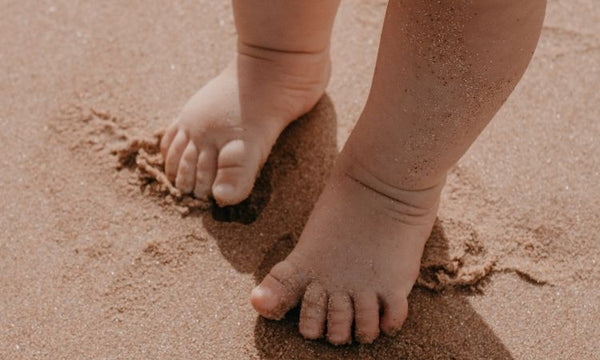
When you were little, did you ever shuffle your socked feet along the carpet, then zap your little brother with just a light touch?
Of course not. Kids don’t do that.
If you did, hypothetically of course, you’ve felt the effects of earthing, or grounding.
Chances are, the concept of this article sounds a little hippy dippy to you. You may have pictured someone standing barefoot outside to be one with the earth’s energy, and you wonder what the point is.
Is there science behind earthing? Yes, and it’s solid enough to make you want to dig your toes into the grass daily. Read on to find out about the benefits of earthing and how you can use grounding mats, grounding sheets, earthing shoes, and the good ‘ol outdoors to reset your body systems.
What is earthing

Before we get into what it all means, there’s a basic premise of physics that helps it all make more sense: you, and all people, animals, plants, and inanimate objects are electrical beings living in an electrical world. Everything that’s made of atoms (so…everything) has a net charge that’s either positive, negative, or neutral.
Every chemical reaction, any rearrangement of molecules that happens anywhere ever, involves electrical charges, attraction, and repulsion. Without atoms’ strong attraction to each other through energetic bonds, you and the device you’re using to read this would dissipate into particles.
So, when your body’s overall charge is off, chemical reactions happen that shouldn’t, and reactions fail to happen when they should. A growing body of evidence shows that disruption of the body’s charge is a health concern, and doctors should start paying attention.[1] More on how your charge gets messed up in a minute.
Earth has a cyclical pulsed negative charge

The earth naturally has an endless supply of negative electrons that pulse out in a pattern.[2] Natural rhythms of radiation from the sun, lightning, and the earth’s orbit recharge this supply in a cycle.
The earth’s surface conducts energy, except in super arid desert areas. That’s why electricity wants to find the ground through the path of least resistance. Think about touching a metal pole and getting a little shock. That surge is the static electricity leaving your body, taking a ride down the pole and eventually getting into the ground. Grounding means discharging built-up static electricity either directly into the earth, or through a conductor and into the ground. Earthing is a little more specific. When your body is in direct contact with the earth, without a barrier like shoes or carpet, you’re earthing.
Why you should ground yourself: the benefits of earthing
Your normal day-to-day builds up a positive charge in the body. Until the last few hundred years, people spent a lot of time in contact with the earth, either walking or sleeping on the ground without anything blocking the transfer of electrons. That was a natural mechanism for getting back to neutral throughout the day and while they slept.
We don’t get that these days. Things like wearing shoes and walking around in buildings prevents you from discharging the charge you’ve built up into the ground.
The benefits of grounding yourself

So, why bother earthing? Some of the science-backed benefits of grounding include:
- Regulates cortisol, your body’s main stress hormone[3] (better regulation means you recover from stress quickly, instead of having feeling anxious long after the stressful event)
- Neutralizes free radicals,[4] which are highly reactive molecules that damage cells
- Reduces inflammation[5]
- Reduces stress[6]
- Improves sleep[7]
- Reduces some risk factors of cardiovascular disease[8]
- Reduces pain[9]
- Shifts the body from the stressed fight-or-flight mode to the restorative rest-and-digest mode[10]
Grounding techniques
The best way to ground yourself is to go outside in the dirt or sand barefoot. If you have a concrete or ceramic tile floor in your basement, that works too as long as it’s sitting on a concrete slab and not on plywood boards or other insulators. If you want a little extra earthing action, or live in a big city where soil is scarce, you have a few options.
Earthing sheet
Every house has a network of grounding wires that connects the electrical source to the ground. This helps complete the circuit using the ground instead of your body, so you can touch your TVs and blenders and whatnot without getting a zap.
An earthing sheet plugs into a normal outlet and connects to the grounding wires in your home’s wiring (not the electrical source, so don’t worry about plugging in all night). Since it conducts energy all the way into the ground, you can get in a full night of earthing in without sleeping in the grass. It’s usually made of cotton and fine silver thread for conductivity, so the sheet will deliver negative electrons from the earth to your body and neutralize the positive charges.
Earthing shoes
Earthing shoes have a small conductor in part of the sole, usually the ball, providing an electric path to the ground. These are popular as casual shoes to provide all-day grounding or as minimalist exercise shoes to increase endurance. Not all minimalist shoes are earthing shoes, though. Rubber soles are insulators, so you have to have a conductive material either woven into the sole or as an embedded disc that connects the soles of your feet to the ground.
Earthing mat
All electronic devices emit EMFs which can disrupt your charge. You can use an earthing mat under your forearms or under your bare feet when you’re working on your computer to reduce rattling your system with EMF exposure.
So, does it work?
Preliminary evidence points to yes. Honestly though, do you need a pointy-head scientist’s absolute certainty to kick off your shoes? Going outside and running around barefoot just makes you feel good. If you notice positive changes over time, even better.
ABOUT COURTNEY SPERLAZZA, MPH
Courtney Sperlazza, MPH, is an epidemiologist who has worked in medical research on projects ranging from breast cancer epidemiology to end-of-life decision-making. When she’s not researching, she’s running biohacking experiments on herself, competing with her husband at everything, or taxiing her kids to sports, not in that order.
REFERENCES
[1] https://www.ncbi.nlm.nih.gov/pubmed/17572456...
[2] https://agupubs.onlinelibrary.wiley.com/doi/...
[3] https://www.ncbi.nlm.nih.gov/pubmed/19083655...
[4] https://www.ncbi.nlm.nih.gov/pubmed/19524846
[5] https://www.ncbi.nlm.nih.gov/pubmed/19524846
[6] http://www.next-up.org/pdf/ACM_Journal_The_B...
[7] https://www.ncbi.nlm.nih.gov/pubmed/15650465...
[8] https://www.liebertpub.com/doi/pdf/10.1089/a...










